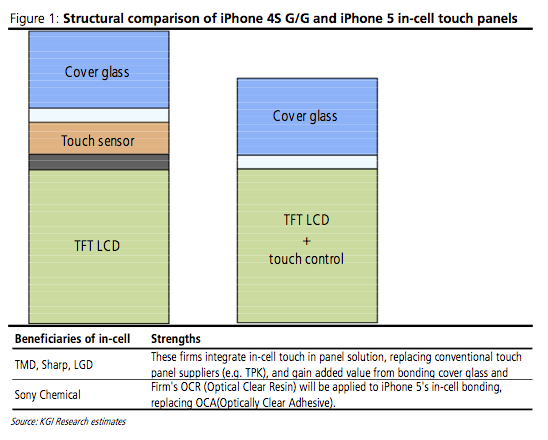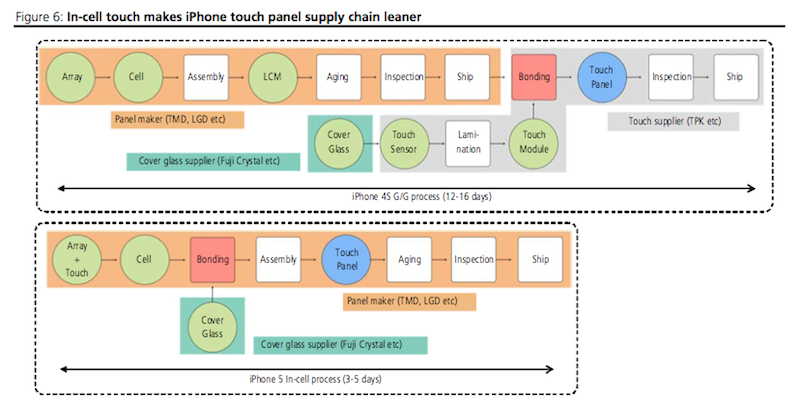In-cell touch panels expected to shave 0.4mm off Apple's next iPhone
KGI Securities analyst Ming-Chi Kuo recently issued a report agreeing with recent rumors that Apple will introduce in-cell touch panels on its next iPhone. According to his research, the new display design, which would embed the touch sensor within the TFT LCD, could result in thickness savings of as much as 0.44mm by removing the separate touch sensor layer and one layer of adhesive.
Apple's current-generation iPhone 4S is 9.3mm thick. Kuo believes the company is aiming to break the 8mm mark with its next handset in order to stay competitive with thin designs from rival smartphone makers.
He calculated that a thinner battery and the rumored switch to a metal back instead of glass could result in further reduced thickness of 0.96mm. As such, Kuo predicts that the depth of the next iPhone will measure 7.90mm.
The analyst also cited "more efficient supply chain management" and improved production yield as reasons that Apple would adopt the in-cell technology. With the current glass-on-glass design, bonding occurs at a late stage in the production process, thereby resulting in "significant losses" if the bonding fails. Kuo believes in-cell production is quicker and and more efficient because bonding comes earlier in the process.
The new process would require an estimated three semi-finished items at bonding, compared to the six required to produce the iPhone 4S. Additionally, production procedures could be cut from eight to five. The analyst also suggested that the number of production days required could drop from 12 to 16 to three to five.
"Another advantage of using in-cell touch is the shorter lead time for touch panel, its most valuable component, and adjusted activities at the supply end, allowing more precisely tailored products to meet market needs, eventually reducing production costs by an estimated 10-20%," Kuo wrote.
The switch would reportedly involve the use of Optical Clear Resin (OCR) instead of Optically Clear Adhesive (OCA). OCR bondings can be re-done, while current OCA bondings can't. Though OCR bondings have had low yields in the past, an open-cell technique addresses these issues.
If Apple were to switch to in-cell panels, conventional touch panel makers, such as TPK, would likely see a substantial decline in panel orders. KGI downgraded TPK to an underperform rating on the assumption that the company's shipments will "start to fall considerably" in the third quarter of 2012.
"As the smartphone market is dominated by large players, lost iPhone business won’t be made up by orders from other smartphone brands," he said.
Toshiba Mobile Display, Sharp and LG Display are believed to be the companies that will benefit from orders of in-cell touch panels by Apple.
Kuo believes Apple will release its 2012 iPhone in the third quarter of this year. Several other reports have put forth early fall as the likely time frame for a new iPhone launch, though a handful have claimed that the device could arrive as early as this summer.
Apple is expected by many to drop the numbering system for the iPhone as it has with the most recent iPad. As such, the sixth-generation iPhone may simply be referred to as "the new iPhone." Multiple reports have claimed that the Cupertino, Calif., company's next handset will also follow the iPad's lead by incorporating 4G LTE connectivity.
 Josh Ong
Josh Ong












 Mike Wuerthele
Mike Wuerthele

 Malcolm Owen
Malcolm Owen
 Chip Loder
Chip Loder

 William Gallagher
William Gallagher
 Christine McKee
Christine McKee
 Michael Stroup
Michael Stroup






